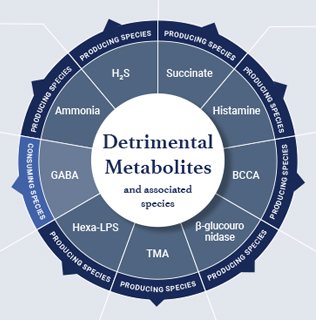Gut reaction: How living environment affects the microbiome
Author: Dr Kaylyn Tousignant
June 2021

As a healthcare practitioner, you probably consider many aspects of your patient’s general lifestyle when assessing their overall health. But more specifically, have you considered the impact of their living environment on their microbiome?
While research continues to unlock important insights into the role of the microbiome in human health, it remains difficult to define what exactly a ‘healthy’ microbiome looks like. Recent studies using high-resolution metagenomic sequencing have started to address this by looking at associations between various lifestyle factors, the gut microbiome and health outcomes in large-scale population studies. This has allowed researchers to explore the effects of a diverse range of environmental exposures – known as the exposome – on the composition and function of the human gut microbiome. And while a healthy diet high in fibre plays an important role, there may be some other surprising lifestyle factors that contribute to the health of your patient’s gut microbiome (see fig 1)2.

Genes have less of an impact on the microbiome than who we live with
Understanding your patient’s family medical history is an important part of their holistic treatment. However, recent studies suggest that when it comes to the gut microbiome, environmental factors have the potential to shape our microbiome more than our genes. A study using metagenomic sequencing profiled the gut microbiomes of 79 pairs of related individuals (ranging from first to fifth-degree relatives) compared to 32 pairs of genetically unrelated individuals who lived together3. Interestingly, the microbiomes of cohabiting pairs were more similar than those living apart, regardless of whether they were related or not. Likewise, microbiomes of relatives living separately were no more alike than unrelated pairs. This supports an earlier metagenomic study of twins showing that a core set of gut microbiome taxa and functions were heritable – particularly genera in the Clostridia and Bacteroidia classes and butyrate-producing bacterium from the family Lachnospiraceae4. However, the microbiomes of twin pairs were less similar when they lived apart from a younger age and for a longer period. This adds to a growing body of evidence that shows your environment (in this case, who you live with) actually has a more important impact on the microbiome than genetics. Fortunately, this provides the opportunity to modify the microbiome through healthy lifestyle habits and environmental exposures.
Some bacteria are impacted by antibiotics while others are more sensitive to changes in living environment
While many studies focus on the impacts of different lifestyle factors on the gut microbiome, a recent study investigated which factors determined the persistence of species within the gut microbiome5. Overall, it was shown that the gut microbiome is relatively stable with bacterial strains having on average a 95% chance of still being present 1 year later. As might be expected strain persistence was shown to be lower in children, who are still developing their unique microbiome, and in those who had been exposed to antibiotics. Interestingly, this study showed that species within the Bacteroidota phylum were likely to show the highest persistence within individuals, families and geographic regions but were particularly sensitive to antibiotic interventions. In contrast, bacterial species within the Firmicutes phylum tended to be less stable with their persistence relying on continual reinfection from external sources. This means that living environment likely plays an important role in the types of Firmicutes bacteria present in the gut microbiome. This is good news because it means that our environment shapes our microbiome throughout life and may explain why in Microba’s own data, individuals who live in homes with a garden generally have a microbiome with higher microbial diversity6; this could be due to an increase in the range of microorganisms within their living environment.
Smoking impacts gut microbiome composition which can lead to negative health consequences
In contrast, Microba’s own research has shown that the gut microbiomes of smokers generally have lower microbial diversity than in non-smokers. This is now supported by several metagenomic studies showing that smoking has an impact on an individual’s microbiome composition, including reduced microbial diversity7,8. Those who smoked had higher levels of species associated with poor health, such as Streptococcus parasanguinis and Ruminococcus torques, and lower levels of beneficial butyrate-producing species, such as Coprococcus catus. This adds to the growing body of evidence for the devastating impact smoking has on health with the World Health Organization suggesting that tobacco use is one of the biggest public health threats the world has ever faced9.
Air pollution can affect the gut microbiome more significantly than other known factors
Although your patient might not smoke those living in urban areas may well be exposed to increased levels of air pollution in their living environment. In a recent metagenomic study of 101 individuals living in southern California, researchers found that exposure to the air pollutants Nitrogen Oxide (NO), Nitrogen Dioxide (NO2) and Ozone (O3) actually explained the largest proportion of microbiome variance compared to other factors known to affect the gut microbiome such as age, BMI and sex10. Exposure to O3 had the largest impact on the gut microbiome, with a significant correlation observed between higher exposure and lower microbial diversity. Furthermore, 128 species were significantly associated with levels of O3 exposure, with the strongest positive association being observed for Bacteroides caecimuris10.
Want to know which bacteria are associated with health & which are associated with disease? Find out in our Functions to Species Guide.
The Nature Prescription
Combined this tells us that avoiding environmental toxins while increasing access to a diversity of microorganisms through increased exposure to natural environments can play an important role in microbiome health. In addition to dietary recommendations, you may consider advising your patients to spend more time in nature. In fact, individuals who spent at least 2 hours a week in nature reported higher levels of health and well-being than those who spent less time in nature11. It did not matter if this was one longer outing or several shorter visits, it seems that just getting out in nature is what is important.
Summary
While diet and physical exercise are important tools for improving gut health, there are plenty of other factors that influence microbiome composition and function that might be leveraged to improve the health of your patient’s microbiome. Using world-class metagenomic sequencing, Insight™ gut microbiome analysis can provide a comprehensive view of the gut microbiome, including key features such as microbial diversity and butyrate production. Metagenomic research will continue to teach us more about the impact of environmental factors on the gut microbiome; but for now, recommending more time in nature, that they minimise exposure to certain air pollutants, and that they cease smoking are all great ways to improve your patient’s microbiome health and overall wellbeing.
To discuss features of Insight™ including microbial diversity level and butyrate production, contact the healthcare team.
About the author

Dr Kaylyn Tousignant
References:
- National Institute of Environmental Sciences. Microbiome. (2021). https://www.niehs.nih.gov/health/topics/science/microbiome/index.cfm
- Vermeulen R, Schymanski E, Barabási AL, Miller G et al. The exposome and health: Where chemistry meets biology. Science, 2020; 367(6476): 392-396. https://doi.org/10.1126/science.aay3164
- Rothschild, D., Weissbrod, O., Barkan, E. et al. Environment dominates over host genetics in shaping human gut microbiota. Nature 555, 210–215 (2018). https://doi.org/10.1038/nature25973
- Xie H, Guo R, Zhong H et al. Shotgun Metagenomics of 250 Adult Twins Reveals Genetic and Environmental Impacts on the Gut Microbiome. Cell Systems, 2016; 3(6): 572-584.e3. https://doi.org/1016/j.cels.2016.10.004
- Hildebrand F, Gossmann TI, Frioux C, et al. Dispersal strategies shape persistence and evolution of human gut bacteria. Cell Host Microbe, 2021;S1931-3128(21)00236-5. https://doi.org/10.1016/j.chom.2021.05.008
- Parajuli A, Nui N, Puhakka R, et al. Yard vegetation is associated with gut microbiota composition. Sci of the Tot Envi, 2020;713(136707). https://doi.org/10.1016/j.scitotenv.2020.136707
- Zhang W, Li J, Lu S, et al. Gut microbiota community characteristics and disease-related microorganism pattern in a population of healthy Chinese people. Sci Rep. 2019;9(1):1594. https://doi.org/10.1038/s41598-018-36318-y
- Zhernakova A, Kurilshikov A, Jan Bonder M, et al. Population-based metagenomics analysis reveals markers for gut microbiome composition and diversity. Science, 2017; 352(6285): 565-569. https://doi.org/10.1126/science.aad3369
- World Health Organisation 2020, Tobacco, accessed June 2021, <https://www.who.int/news-room/fact-sheets/detail/tobacco>
- Fouladi F, Bailey MJ, Patterson WB, et al. Air pollution exposure is associated with the gut microbiome as revealed by shotgun metagenomic sequencing. Environ Int., 2020; 138 (105604). https://doi.org/10.1016/j.envint.2020.105604
- White MP, Alcock I, Grellier J, et al. Spending at least 120 minutes a week in nature is associated with good health and wellbeing. Scientific Reports, 2019; 9, 7730. https://doi.org/10.1038/s41598-019-44097-3